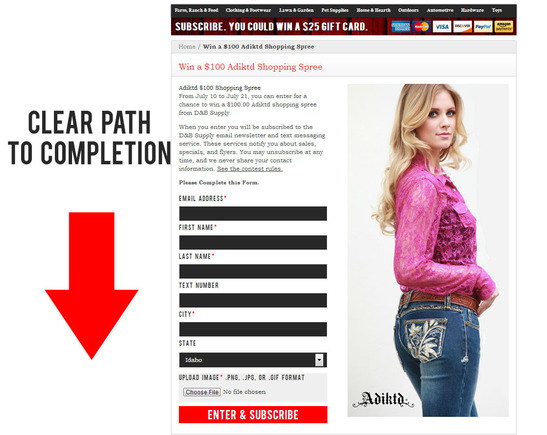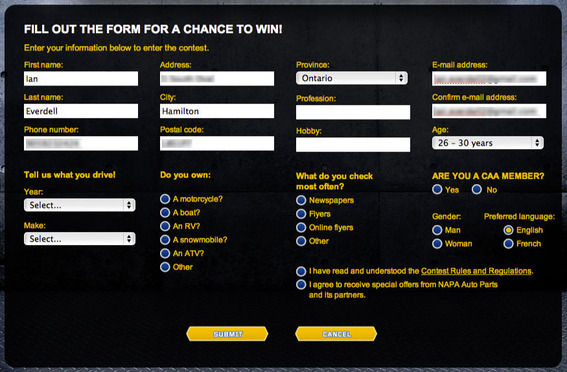Contest marketing is a good way to engage potential customers, increase your social media fan base, give folks positive things to say about your store, and collect data that can improve both your business’s bottom line and your customers’ online experiences.
Consider for a moment just one point made above — contest marketing is a good way to collect data. Ecommerce marketing should begin with a healthy respect for customers and a desire to give them the best possible shopping experience and customer service. Often, online retailers can do a better job of suggesting related products, sharing special offers, or even customizing an online shopping experience, if those retailers have more or better information about a particular shopper.
For example, imagine an Internet store that offers free shipping with a minimum order of $75. Now imagine a customer who just purchased a couple of men’s work shirts totaling $70. A good merchant might suggest a few related products that cost about five dollars, so that the customer can qualify for free shipping. That is good. But it would be better if this merchant happened to know that this particular customer also buys toys for a girl aged 5 to 7. In addition to recommending an inexpensive belt, the retailer could suggest a four pack of My Little Pony Kiosk Ponies. This customer might not need a cheap belt, but an essentially free gift for a daughter or favorite niece would be a very welcome recommendation.
With contest marketing, shoppers understand that they are exchanging information about themselves for an opportunity to win a prize. This fair exchange allows online sellers to collect the sort of valuable customer information that can be used as described above. And, it also allows for other marketing opportunities.
What follows are four quick tips for building better contest web forms. The goal is to provide entrants with good information and an easy path to completion.
1. Offer a Clear Description or Explanation
Before a potential shopper will provide an email address or combine that address with a name in your database, you’ll need to make a clear offer for something of value. This should be done as succinctly as possible.
Boot Barn, a multi-channel retailer that sells Western fashion boots and clothes, recently launched a new contest. The contest description is very simple and direct.

Clearly explain what the entrant wins.
“With your help, we’ve made it to 1,000,000 Facebook Fans! In celebration of this event, enter before 5pm PT on 7/12 for a chance to win a trip to Cheyenne Frontier Days, $1,000 travel stipend and to see Jason Aldean in concert on July 26th. Must be 18 of age and a US resident.”
While this is not a particularly well-written piece of prose, it coveys what the entrant should expect to win.
2. Have a Clear Path to Completion
For a web form, the path to completion describes the layout of form fields that an entrant must complete. Research from web and mobile expert Luke Wroblewski and others indicates that the path from the first field to the submission button should be obvious.
For example, it may make sense to line up fields vertically, so that there is a direct path that goes from one form field to the next. In a recent Adiktd brand shopping spree contest, the form fields were stacked one on top of the next, so that it was obvious which field was next. The submit button was the same size as the other form inputs and aligned directly below them. It was even possible to tab from one field to the next, making it easy to complete.

Provide a clear path to completion.
3. Ask Only What You Must
As mentioned above, contest marketing can be a good way to get usable information about your customers, but it is important not to ask too much at once. Only ask entrants for information necessary for the contest and specific to a marketing goal.
Last year, Bad Forms published an example of a form that had too many fields. It ask entrants to provide data for 19 fields, including the year and make of their automobile.

Ask too much and you could have a poor contest form.
4. Avoid Mobile Stumbling Blocks
Some contest entrants will, no doubt, be accessing your form from a smartphone or a tablet.
These devices have different capabilities and interfaces than a laptop or desktop computer, and your contest web form should adapt for them. At the very least, it should not create any mobile stumbling blocks that trips up their ability to enter.
For example, if your contest form includes hints or tips to ensure that the user understands what to enter, don’t hide the elements behind a hover effect that your mobile users cannot access.
Similarly, make certain that your form is still readable when a smartphone keyboard is being displayed. In general, test the form several times on a mobile device before launching the contest marketing campaign.



